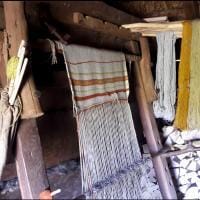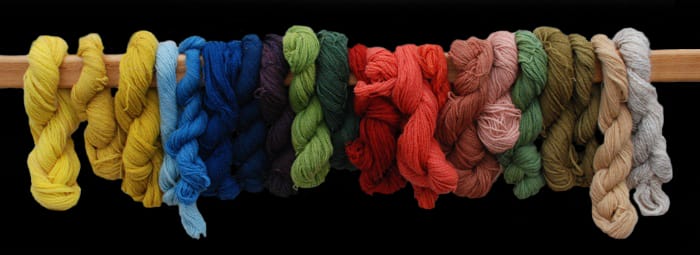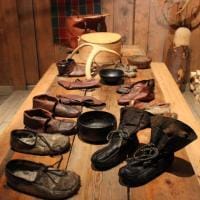Your Cart is Empty
Enjoy Up to 50% Off and Free Shipping! 🌎✈️
Viking era clothing is quite rare to find. Only small pieces of cloth preserved in the graves of individuals mostly belonging to the upper classes of society have been discovered. The reconstitution of their clothing is thus completed by other sources such as representations on amulets, the historiated steles of Gotland, tapestries (Oseberg, Bayeux...), statuettes and stories in historical texts.
Like contemporary men and women, the dress varied according to sex, age, social status and probably the place. Ordinary clothes, pants and tunic for men, dress and apron for women, were made from local materials available, such as wool and linen, woven and sometimes dyed.
The making of clothes was then the responsibility of the women. However, some textiles were imported as shown by pieces of cloth found in the tombs of wealthy people. The upper classes displayed their riches by adorning themselves with silk and gold yarns from distant lands such as the Byzantine Empire.

If clothing is characterized above all by comfort and practicality, all the historical testimonies show that the Vikings gave a certain importance to their appearance. Clothes may have been ironed using heated flat stones, which are part of the archaeological finds. Eventually, the Vikings often ostentatiously complemented their clothing with jewelry.
Linen accounts for about 40% of the fabric discoveries of the Viking Age. It was therefore not only a leading commercial product but also an important culture for clothing design. Several sites in Denmark show that linen was produced on an almost industrial scale during this period. Research has shown that more than 20kg of flax plants were needed to produce enough material to make a single tunic. In addition, from the time the flax was sown until the tunic was sewn - no less than 400 hours of work were required.
=> Hemp and nettle are the other plant fibers commonly used in Scandinavian textile manufacturing.
Wool, carded, spun and woven into a cloth called vaðmál, was used undyed, in all its natural colors ranging from brown to black to gray, for everyday, work or travel clothing. This frequency of undyed clothing seems to have been greater in Iceland than in Scandinavia. However, the white wool, as for it, seems to have been rarely left undyed.

Silk may have been part of the booty of the raids carried out by the Vikings but it was also widely imported thanks to the commercial links they had, especially with Persia and Constantinople, as evidenced by the discoveries in Norway at Ness in the municipality of Hamarøy (Nordland County), in Gokstad (Vestfold county), in Sandanger in the Sunnmøre district, in Nedre Haugen (Østfold county), in Birka near Stockholm, or the hundred or so small silk fragments found in Oseberg's grave.
The latter are decorated with motifs related to the religious symbols of Central Asia, including a Shahrokh, a bird which, in Persian mythology, represents a royal blessing.
Some of the imported silk is woven using a technique called Samite, a sophisticated oriental weaving method. Many pieces of silk were cut into thin strips and used to decorate clothes and accessories such as hats.
Leather was used to make shoes, belts, but also "waterproof" clothing from skins treated with beeswax or fish oil.
Furs (bears, reindeer, sable, martens, squirrels) adorned men's capes, women's shawls and head coverings while allowing to fight against the cold.
Wool was easier to dye than linen, and the colors were more vivid.

Here are the colors mostly used according to archaeological discoveries:
Yellow, probably came from the onion, cultivated by the Scandinavians.
Blue, came either from woad, a local plant, or from indigo, an imported dye. Blue was only found in the burials of wealthy people, suggesting that it was probably a precious color with a sacred character.
Purple, came from the purple lichen and was mainly prized in Ireland and Greenland.
Green, came from a mixture of woad and onion. The green color was only found in Scandinavia.
Red, came from the madder used in France and England, and the fragrant bedstraw, found in Scandinavia. Red was a color highly prized by the Vikings in England and a marker of good fortune.

- Shirts or under-dresses (serk)
The Viking woman sometimes wore, as underwear, a long linen shirt that protruded ostentatiously under the dress and whose collar closed with a ribbon tied at the base of the neck. According to researchers, the Danish women's shirt was simple, while in Sweden it was pleated.
- Dresses
The dress, in linen or most often wool, goes down to the ankles. The collar split to better pass the head could be closed with a fibula. It had long or short sleeves depending on the season. It could be simple, pleated for high-ranking women, or it could be built with additional triangle side panels, called godets to give fullness to the base.
- Aprons (smokkr)
Usually made of wool, it was tubular in shape, or slit on the sides, or added cups from the waist up (to match the size of the dress itself). An apron dress found in Hedeby and dated to the 10th century demonstrates several sophisticated sewing techniques.
Shorter than the dress it was partially covering, the apron was held by straps stapled below the shoulders with fibulas whose shape could vary according to the regions and the period (see jewels below). Often dyed, it could be embroidered or/and braided.
According to another hypothesis, the dress apron was composed of 2 rectangles of fabric (front / back), seamless, with straps fixed in the same way. However, this type of clothing, which has never been confirmed by archaeological discoveries, would ultimately prove impractical for daily tasks.
- Shawls
Made of wool to protect from the cold, the shawl was either rectangular or semicircular in shape, was closed on the chest by a metal buckle or held by the pins of the apron dress. Its borders could be adorned with braid or fur.
- Accessories
In Christianized geographical areas such as Dublin and Jorvik, Viking women seemed to have a wide variety of headdresses.
The headband, was a band of cloth worn around the head, much like a crown. It could be worn alone, or with a scarf or veil pinned to the headband. The richly decorated headband was often made of brocade, a silk cloth with brocaded designs in gold and silver (especially in Sweden), or even woven with bronze spirals (Finland). This type of headband was worn by the women of the Franks, Anglo-Saxons, Alamans, Bavarians, Lombards and Spanish Visigoths.
The scarf, was tied at the nape of the neck and could descend to the back in a long spike, but this accessory is not attested as a generality. Scarves dyed purple with bangs are attested by archaeological finds.
The hood, was made from a rectangle of fabric with a rounding that fell down into the back. It covered the head and neck, with fasteners to attach it under the chin. Examples of this type have been found in Jorvik (York), especially in silk with linen fasteners. A similar one in Dublin was made of wool, more rectangular, and with a stitch at the back of the head.
One hypothesis is that the Viking woman, like the men, wore a leather belt to which she hung the keys to the household chests that held valuables, and a leather purse that could hold small utensils of daily life. This has not been attested by archaeological discoveries, although it has been shown that scissors, knife, keys, ear picks or even small bone needle boxes could be suspended by chains from the fibulae, making them in fact quickly accessible for everyday tasks.

- Shirts
The undershirt was usually simple and made of linen.
- Blouses or tunics
The blouse was straight and half-long, up to mid-thigh, but there was another type, wider and worn with a belt. These two types of clothing are attested by the iconographic representations. They could be decorated with braids woven in a checkerboard pattern with gold or silver threads for the rich, or embroidered with motifs. The collar of the shirt, like the women's dresses, was slit for better passing the head and closed with a fibula.
- Breeches
The breeches, made of linen or wool, were sometimes long and narrow, sometimes wide and puffy. They could be tied with a tie under the knees.
The wide breeches made up a ceremonial outfit. Those found in Hedeby were even pleated. They required the wearing of stockings held together with staples or strips of cloth, the remains of which have been found in burials.
- Cloaks and Coats
The cloak was attached to the right shoulder or under the arm with a fibula, usually pennular. It could be decorated with braids and lined with a rich fabric or fur. In order to ensure a better protection against cold, wind and water, it was sometimes lined with a woollen cloth, or even quilted with down.
The coat, also known as "caftan" or "Rus riding coat," seems to have been a garment of Eastern influence, according to the discoveries of the 9th and 10th centuries made in Birka. Closed from the neck to the waist with wooden or bone buttons, and decorated with specific and intricate metal trimmings, this garment was borrowed or adapted from the Byzantine skaramangion, which was a standardized garment at the emperor's court.
- Accessories
Various head coverings were in use, woollen hats but also hats with rounded shapes, or with a point, both sometimes trimmed with fur and/or richly decorated with silk, silver trimmings, or gold pastes and ribbons.
The belt, made of leather, was used to attach to the waist, a leather purse containing any object useful in everyday life, from coins to game pieces, as well as a knife. It could be simple, or decorated with a buckle, a bite and small ornamented yokes.
- Shoes
They were made of leather, sometimes in a single piece maintained and closed by a leather lace, sometimes composed of 2 pieces of leather to which a sole was sewn.
Some thinner shoes may have been decorated with various motifs as suggested by shoes from the end of the 12th century discovered in the Bryggen district of Bergen (Norway), decorated with embroidered runes along the opening up to the tip of the foot, or others decorated with incised volutes.
The Vikings also used boots of different sizes.

- Jewelry
Men and women from all walks of life wore jewelry in the form of arm rings, necklaces, rings and brooches. According to archaeological findings, Vikings did not wear earrings.
Jewelry could be made from various materials such as wood, glass, amber, iron, bronze, silver and gold. Jewelry was often decorated with geometric patterns, interlacing, animal heads, and the motif of the grasping beast.
Scandinavian goldsmiths mastered a wide range of manufacturing and decorative techniques, including casting, drawing and braiding, engraving, filigree and granulation, chasing, plating, glasswork, and gem inlaying. The only technique to have been absent from their repertoire is that of enamel.
The jewels had different functions such as:
- element of adornment,
- symbol of social or economic status
- fastening system to close clothes or attach accessories
- symbol of protection or beliefs
- means of payment for trade
- Amulets
Amulets and various lucky charms were worn as necklaces.
The most common amulet in Viking times was Thor's hammer, called Mjölnir.
It was mainly made of iron or silver, but there are also bronze and amber hammers. They came in all sizes. There are those without any decoration, those with embossed decoration and those decorated with a filigree, on one side only or both.
- Pearls & Beads
The beads are present in most of the women's graves unearthed by archaeologists. Nearly 300 glass beads have been found in Coppergate, (near York, England), and the overwhelming majority of them were of a single color. Others are worked with dots and patterns of different colors.
The most popular colors were blue, green and yellow.
Beads of amber, bone, antler, shell and stone were also found.
